
Soldiers demonstrate mission oriented protective posture (MOPP) gear change during chemical, biological, radiological and nuclear training at Camp Casey/Hovey, Republic of Korea in November. Pfc. Hyeonmin Lee / U.S. Army
Senator: The U.S. Military is Preparing for a War with North Korea That It Hopes Never to Fight
Most Americans are not aware of "just how close we are to war on the Korean peninsula," says Sen. Tammy Duckworth, D-Ill.
When Senator Tammy Duckworth returned from a recent trip to South Korea and Japan, she brought back a sobering message: “Americans simply are not in touch with just how close we are to war on the Korean peninsula.” In a speech at Georgetown University, she laid out the U.S. military maneuvers over the past several months—including a nuclear-powered submarine heading to South Korea, the movement of three aircraft carriers to the Western Pacific, and the Army testing out “mobilization centers” for deploying troops and training soldiers to fight in tunnels like those beneath North Korea—that inform this worry. In an interview with me, she said the U.S. military seems to be operating with the attitude that a conflict “‘will probably happen, and we better be ready to go.’”
The Illinois Democrat believes this is primarily a response to the rhetoric coming out of Washington, where members of the Trump administration have repeatedly threatened to use force if diplomacy fails to prevent North Korea from acquiring the capability to strike the United States with nuclear missiles. And even though the administration continues to emphasize its preference for a diplomatic solution, “I feel like the military hears the war-mongering tendencies coming out of the executive branch and many in the legislative branch and have seen the writing on the wall and they said, ‘Holy cow. We’re more likely to be called on now than we were two years ago,’” Duckworth said.
“I know that the military’s job is to be fully ready for any contingency, and I commend them and support them for continuing to prepare for war. I’m not saying that they’re going to war,” Duckworth said at Georgetown. “But it’s painfully clear from my visit to the [Korean Demilitarized Zone] and these movements that I am seeing that we shouldn’t ignore the signals that our military is sending with these actions. We know that the North Koreans and our allies in the region are certainly paying attention.”
Duckworth, a retired lieutenant colonel who lost her legs during the Iraq War when insurgents downed her helicopter, took the trip along with Ruben Gallego, a Democratic congressman from Arizona and a fellow Iraq War veteran, earlier this month. The two met with top South Korean and Japanese diplomats and defense officials as well as commanders of U.S. forces in South Korea. Duckworth said that she found “all three of the major military actors—American, Korean, and Japanese—...more ready [for war] than they’ve ever been.”
The U.S. military, she said, is “beyond the training stage. They’re at the getting ready for operational readiness state, with—and I heard this time and time again—hope that they never have to” fight.
The drums of war are not booming; there have been no major U.S. military movements or public-messaging campaigns by the Trump administration or new advisories to American civilians or companies, for instance. And Duckworth thinks there are ways the country should be more prepared—in particular that Congress should create a dedicated stream of funding for U.S. forces to rehearse and carry out evacuations of non-combatants in the event of a conflict. (So far there have been no evacuations of American non-combatants from South Korea, which would be a glaring sign of imminent conflict.)
But, as Duckworth sees it, the drumbeats are growing louder—even as the administration has stayed comparatively silent about what war would look like and whether the benefits would warrant the costs. Duckworth and Gallego have requested a more detailed accounting from the White House and the Pentagon, respectively, and warned of the costs of even limited preventive military action. In response to Gallego, the Pentagon admitted that fully securing North Korea’s nuclear weapons would require a U.S. ground invasion. And Duckworth said that disabling North Korean artillery batteries, which are capable of devastating the South Korean capital of Seoul, would probably require a massive influx of U.S. ground troops as well. Kim Jong Un, she added, will be tempted to use his chemical or biological weapons if he fears he’s about to lose power. “We can’t control escalation,” Duckworth said. She noted that the South Korean and Japanese officials she met with wanted the Trump administration to give its international sanctions campaign against North Korea more time to work before resorting to other measures.
“We have some great plans should, as we say, ‘the balloon go up’ in Korea,” Gallego, a former Marine, told me. “I know what happens with plans when the first bullet goes flying. … What I fear is that someone like Donald Trump will look at these great plans, look at our great military, which it is, look at their great capability, which we have, and not understand that these are not superhumans—that if we do something wrong, we will potentially kill hundreds of thousands of people, including some of our own troops, and potentially disrupt a good portion of the world’s economy for years to come.” And that’s considering only the early stages of battle and assuming the conflict doesn’t go nuclear.
“You’re basing policy and military action on hopes instead of on reality and sound reasoning,” Gallego said. “Does this sound familiar? For me it does, as somebody who ended up serving on the front lines of the Iraq War, where I was supposed to be greeted as a liberator. Instead I basically got shot at every day.”
Robert Neller, the commandant of the U.S. Marine Corps, acknowledged the limitations of military plans during an appearance at the Center for Strategic and International Studies on Thursday. “If [a U.S. conflict with North Korea] were to go down, I’m not now so sure it’s going to go down the way we planned. It never does,” he said. Neller stressed that he hopes such a fight never breaks out. Nevertheless, “we want to be ready, and we want to have a capability that allows our diplomats to come up with a diplomatic solution.”
Neller said he and other heads of the armed services have gotten “familiar with the geography … [and] the plans” and done “some logistical preparation that’s just prudent.” He added that U.S. Forces Korea and U.S. Pacific Command are busy training, conducting exercises, and exploring “force deployment options” to convey to the “other side” that “you really don’t want to do this.” Meanwhile, the other side is making its own preparations. Alexander Vorontsov, a Russian Korea scholar, recently wrote that North Korean Foreign Ministry officials he visited in Pyongyang in November told him they did “not want war” but would “not hide from it either.” They “feared that the U.S. was already trying to shape the battlefield for a military operation against the North.” And, Vorontsov continued, the North Korean government “is not bluffing when it says that ‘only one question remains: When will war break out?’ … [O]ur counterparts emphasized that ‘our soldiers have long been sleeping without removing their boots.’”
In such circumstances, Gallego worries that “we [could] trip ourselves into a war” no one wants—if, “for example, the North assumes one of our moves is a strike and they decide to do a preemptive strike.” Neller might respond that one of the points of U.S. military preparations is to prevent war by deterring the adversary. And perhaps war will indeed be averted. Then again, perhaps not. As the World War I historian Margaret MacMillan told me not long ago, “Once you get into a countdown situation, once people begin to think of war as likely, then it becomes that much more likely”—whether as a result of deliberate decisions, tragic miscalculation, or mere mistake.







